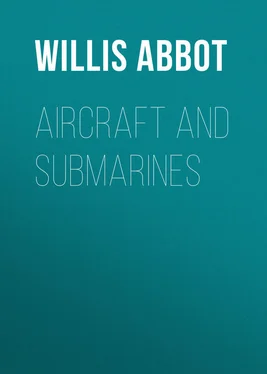Willis Abbot - Aircraft and Submarines
Здесь есть возможность читать онлайн «Willis Abbot - Aircraft and Submarines» — ознакомительный отрывок электронной книги совершенно бесплатно, а после прочтения отрывка купить полную версию. В некоторых случаях можно слушать аудио, скачать через торрент в формате fb2 и присутствует краткое содержание. Жанр: foreign_antique, foreign_prose, на английском языке. Описание произведения, (предисловие) а так же отзывы посетителей доступны на портале библиотеки ЛибКат.
- Название:Aircraft and Submarines
- Автор:
- Жанр:
- Год:неизвестен
- ISBN:нет данных
- Рейтинг книги:4 / 5. Голосов: 1
-
Избранное:Добавить в избранное
- Отзывы:
-
Ваша оценка:
- 80
- 1
- 2
- 3
- 4
- 5
Aircraft and Submarines: краткое содержание, описание и аннотация
Предлагаем к чтению аннотацию, описание, краткое содержание или предисловие (зависит от того, что написал сам автор книги «Aircraft and Submarines»). Если вы не нашли необходимую информацию о книге — напишите в комментариях, мы постараемся отыскать её.
Aircraft and Submarines — читать онлайн ознакомительный отрывок
Ниже представлен текст книги, разбитый по страницам. Система сохранения места последней прочитанной страницы, позволяет с удобством читать онлайн бесплатно книгу «Aircraft and Submarines», без необходимости каждый раз заново искать на чём Вы остановились. Поставьте закладку, и сможете в любой момент перейти на страницу, на которой закончили чтение.
Интервал:
Закладка:
But to return to the first Zeppelin. Her trial was set for July 2, 1900, and though the immediate vicinity of the floating hangar was barred to the public by the military authorities, the shores and surface of the lake were black with people eager to witness the test. Boats pulled out of the wide portal the huge cigar-shaped structure, floating on small rafts, its polished surface of pegamoid glittering in the sun. As large as a fair-sized ocean steamship, it looked, on that little lake dotted with pleasure craft, like a leviathan. Men were busy in the cars, fore and aft. The mooring ropes were cast off as the vessel gained an offing, and ballast being thrown out she began to rise slowly. The propellers began to whir, and the great craft swung around breasting the breeze and moved slowly up the lake. The crowd cheered. Count von Zeppelin, tense with excitement, alert for every sign of weakness watched his monster creation with mingled pride and apprehension. Two points were set at rest in the first two minutes – the lifting power was great enough to carry the heaviest load ever imposed upon a balloon and the motive power was sufficient to propel her against an ordinary breeze. But she was hardly in mid-air when defects became apparent. The apparatus for controlling the balancing weight got out of order. The steering lines became entangled so that the ship was first obliged to stop, then by reversing the engines to proceed backwards. This was, however, a favourable evidence of her handiness under untoward circumstances. After she had been in the air nearly an hour and had covered four or five miles, a landing was ordered and she dropped to the surface of the lake with perfect ease. Before reaching her shed, however, she collided with a pile – an accident in no way attributable to her design – and seriously bent her frame.
The story told thus baldly does not sound like a record of glorious success. Nevertheless not Count Zeppelin alone but all Germany was wild with jubilation. Zeppelin I. had demonstrated a principle; all that remained was to develop and apply this principle and Germany would have a fleet of aërial dreadnoughts that would force any hostile nation to subjection. There was little or no discussion of the application of the principle to the ends of peace. It was as an engine of war alone that the airship appealed to the popular fancy.
But at the time that fancy proved fickle. With a few repairs the airship was brought out for another test. In the air it did all that was asked for it, but it came to earth – or rather to the surface of the lake – with a shock that put it out of commission. When Count Zeppelin's company estimated the cost of further repairs it gave a sigh and abandoned the wreck. Thereupon the pertinacious inventor laid aside his tools, got into his old uniform, and went out again on the dreary task of begging for further funds.
It was two years before he could take up again the work of construction. He lectured, wrote magazine articles, begged, cajoled, and pleaded for money. At last he made an impression upon the Emperor who, indeed, with a keen eye for all that makes for military advantage, should have given heed to his efforts long before. Merely a letter of approval from the all-powerful Kaiser was needed to turn the scale and in 1902 this was forthcoming. The factories of the empire agreed to furnish materials at cost price, and sufficient money was soon forthcoming to build a second ship. This ship took more than two years to build, was tested in January, 1906, made a creditable flight, and was dashed to pieces by a gale the same night!
The wearisome work of begging began again. But this time the Kaiser's aid was even more effectively given and in nine months Zeppelin III. was in the air. More powerful than its predecessors it met with a greater measure of success. On one of its trials a propeller blade flew off and penetrated the envelope, but the ship returned to earth in safety. In October, 1906, the Minister of War reported that the airship was extremely stable, responded readily to her helm, had carried eleven persons sixty-seven miles in two hours and seventeen minutes, and had made its landing in ease and safety. Accepted by the government "No. III." passed into military service and Zeppelin, now the idol of the German people, began the construction of "No. IV."
That ship was larger than her predecessors and carried a third cabin for passengers suspended amidships. Marked increase in the size of the steering and stabling planes characterized the appearance of the ship when compared with earlier types. She was at the outset a lucky ship. She cruised through Alpine passes into Switzerland, and made a circular voyage carrying eleven passengers and flying from Friedrichshaven to Mayence and back via Basle, Strassburg, Mannheim, and Stuttgart. The voyage occupied twenty-one hours – a world's record. The performance of the ship on both voyages was perfection. Even in the tortuous Alpine passes which she was forced to navigate on her trip to Lucerne she moved with the steadiness and certainty of a great ship at sea. The rarification of the air at high altitudes, the extreme and sudden variations in temperature, the gusts of wind that poured from the ice-bound peaks down through the narrow canyons affected her not at all. When to this experience was added the triumphant tour of the six German cities, Count von Zeppelin might well have thought his triumph was complete.
But once again the cup of victory was dashed from his lips. After his landing a violent wind beat upon the ship. An army of men strove to hold her fast, while an effort was made to reduce her bulk by deflation. That effort, which would have been entirely successful in the case of a non-rigid balloon, was obviously futile in that of a Zeppelin. Not the gas in the ballonets, but the great rigid frame covered with water-proofed cloth constituted the huge bulk that made her the plaything of the winds. In a trice she was snatched from the hands of her crew and hurled against the trees in a neighbouring grove. There was a sudden and utterly unexpected explosion and the whole fabric was in flames. The precise cause of the explosion will always be in doubt, but, as already pointed out, many scientists believe that the great volume of electricity accumulated in the metallic frame was suddenly released in a mighty spark which set fire to the stores of gasoline on board.
With this disaster the iron nerve of the inventor was for the first time broken. It followed so fast upon what appeared to be a complete triumph that the shock was peculiarly hard to bear. It is said that he broke down and wept, and that but for the loving courage and earnest entreaties of his wife and daughter he would then have abandoned the hope and ambition of his life. But after all it was but that darkest hour which comes just before the dawn. The demolition of "No. IV." had been no accident which reflected at all upon the plan or construction of the craft – unless the great bulk of the ship be considered a fundamental defect. What it did demonstrate was that the Zeppelin, like the one-thousand-foot ocean liner, must have adequate harbour and docking facilities wherever it is to land. The one cannot safely drop down in any convenient meadow, any more than the other can put into any little fishing port. Germany has learned this lesson well enough and since the opening of the Great War her territory is plentifully provided with Zeppelin shelters at all strategic points.
Fortunately for the Count the German people judged his latest reverse more justly than he did. They saw the completeness of the triumph which had preceded the disaster and recognized that the latter was one easily guarded against in future. Enthusiasm ran high all over the land. Begging was no longer necessary. The Emperor, who had heretofore expressed rather guarded approval of the enterprise, now flung himself into it with that enthusiasm for which he is notable. He bestowed upon the Count the Order of the Black Eagle, embraced him in public three times, and called aloud that all might hear, "Long life to his Excellency, Count Zeppelin, the Conqueror of the Air." He never wearied of assuring his hearers that the Count was the "greatest German of the century." With such august patronage the Count became the rage. Next to the Kaiser's the face best known to the people of Germany, through pictures and statues, was that of the inventor of the Zeppelin. The pleasing practice of showing affection for a public man by driving nails into his wooden effigy had not then been invented by the poetic Teutons, else von Zeppelin would have outdone von Hindenburg in weight of metal.
Читать дальшеИнтервал:
Закладка:
Похожие книги на «Aircraft and Submarines»
Представляем Вашему вниманию похожие книги на «Aircraft and Submarines» списком для выбора. Мы отобрали схожую по названию и смыслу литературу в надежде предоставить читателям больше вариантов отыскать новые, интересные, ещё непрочитанные произведения.
Обсуждение, отзывы о книге «Aircraft and Submarines» и просто собственные мнения читателей. Оставьте ваши комментарии, напишите, что Вы думаете о произведении, его смысле или главных героях. Укажите что конкретно понравилось, а что нет, и почему Вы так считаете.












